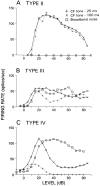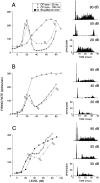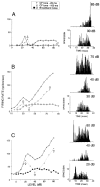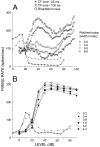Response classes in the dorsal cochlear nucleus and its output tract in the chloralose-anesthetized cat
- PMID: 9570822
- PMCID: PMC6793160
- DOI: 10.1523/JNEUROSCI.18-10-03955.1998
Response classes in the dorsal cochlear nucleus and its output tract in the chloralose-anesthetized cat
Abstract
Neurons in the dorsal cochlear nucleus (DCN) can be classified into three major physiological classes on the basis of responses to pure tone and broadband noise stimuli. A circuit diagram that associates these classes with different cell types has been proposed. According to this proposal, type II cells are inhibitory interneurons that respond well to tones and poorly to broadband noise, type IV cells are projection neurons with the opposite behavior, and type III cells are an inhomogeneous class with intermediate properties. To test the associations proposed, I compared the response type distribution in the DCN with its output tract, the dorsal acoustic stria (DAS), in chloralose-anesthetized cats. Axonal recordings in the DAS showed type III and IV responses as in DCN, but no type II responses. Compared with reports in decerebrate animals, fewer type IV neurons were encountered having sustained inhibition that generated strongly nonmonotonic responses to tones in both DCN and DAS. The presence of type II responses in the nucleus, but not in the output tract, offers strong support for the proposed association with DCN interneurons. On the other hand, the distinction between type III and IV responses needs refinement because the differences are only graded and because both types of responses occur in DAS, which shows that they are both associated with projection neurons.
Figures










Similar articles
-
Temporal and binaural properties in dorsal cochlear nucleus and its output tract.J Neurosci. 1998 Dec 1;18(23):10157-70. doi: 10.1523/JNEUROSCI.18-23-10157.1998. J Neurosci. 1998. PMID: 9822769 Free PMC article.
-
Spectral integration by type II interneurons in dorsal cochlear nucleus.J Neurophysiol. 1999 Aug;82(2):648-63. doi: 10.1152/jn.1999.82.2.648. J Neurophysiol. 1999. PMID: 10444663
-
Temporal and mean rate discharge patterns of single units in the dorsal cochlear nucleus of the anesthetized guinea pig.J Neurophysiol. 1996 Sep;76(3):1667-88. doi: 10.1152/jn.1996.76.3.1667. J Neurophysiol. 1996. PMID: 8890284
-
Why do cats need a dorsal cochlear nucleus?J Basic Clin Physiol Pharmacol. 1996;7(3):199-220. doi: 10.1515/jbcpp.1996.7.3.199. J Basic Clin Physiol Pharmacol. 1996. PMID: 8910137 Review.
-
Neural organization and responses to complex stimuli in the dorsal cochlear nucleus.Philos Trans R Soc Lond B Biol Sci. 1992 Jun 29;336(1278):407-13. doi: 10.1098/rstb.1992.0076. Philos Trans R Soc Lond B Biol Sci. 1992. PMID: 1354382 Review.
Cited by
-
Temporal and binaural properties in dorsal cochlear nucleus and its output tract.J Neurosci. 1998 Dec 1;18(23):10157-70. doi: 10.1523/JNEUROSCI.18-23-10157.1998. J Neurosci. 1998. PMID: 9822769 Free PMC article.
-
Enhancement of phase-locking in rodents. I. An axonal recording study in gerbil.J Neurophysiol. 2017 Oct 1;118(4):2009-2023. doi: 10.1152/jn.00194.2016. Epub 2017 Jul 12. J Neurophysiol. 2017. PMID: 28701535 Free PMC article.
-
Changes in the latency of mouse inferior colliculus neuron responses depending on the position and direction of movement of spectral contrast.Neurosci Behav Physiol. 2005 Sep;35(7):723-36. doi: 10.1007/s11055-005-0116-z. Neurosci Behav Physiol. 2005. PMID: 16433068
-
Hazard functions and expected spike density functions for neuron spike activity in the cochlear nucleus of the cat.Neurosci Behav Physiol. 2005 Jan;35(1):59-70. doi: 10.1023/b:neab.0000049652.93984.da. Neurosci Behav Physiol. 2005. PMID: 15739789
-
Preparation of an awake mouse for recording neural responses and injecting tracers.J Vis Exp. 2012 Jun 26;(64):3755. doi: 10.3791/3755. J Vis Exp. 2012. PMID: 22781848 Free PMC article.
References
-
- Adams JC. Single unit studies on the dorsal and intermediate acoustic striae. J Comp Neurol. 1976;170:97–106. - PubMed
-
- Adams JC, Warr WB. Origins of axons in the cat’s acoustic striae determined by injection of horseradish peroxidase into severed tracts. J Comp Neurol. 1976;170:107–122. - PubMed
-
- Arle JE, Kim DO. Simulations of cochlear nucleus neural circuitry: excitatory-inhibitory response-area types I–IV. J Acoust Soc Am. 1991;90:3106–3121. - PubMed
-
- Chan JCK, Musicant A, Hind JE. An insert earphone system for delivery of spectrally-shaped signals for physiological studies. J Acoust Soc Am. 1993;93:1496–1501. - PubMed
-
- Davis KA, Ding J, Benson TE, Voigt HF. Response properties of units in the dorsal cochlear nucleus of unanesthetized decerebrate gerbil. J Neurophysiol. 1996;75:1411–1431. - PubMed
Publication types
MeSH terms
Substances
Grants and funding
LinkOut - more resources
Full Text Sources
Miscellaneous
